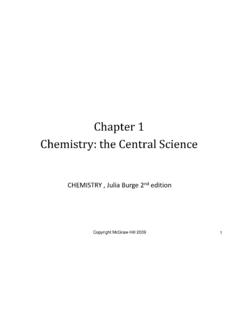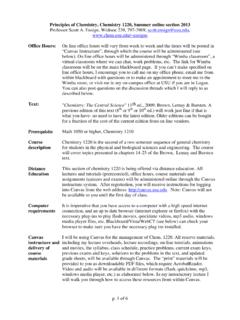Transcription of Chemistry: The Central Science - Pearson School
1 A Correlation of chemistry : The Central Science Twelfth Edition, AP* Edition 2012 to the AP* chemistry Topics chemistry : The Central Science 12/e 2012 Correlated to the AP chemistry Topics AP chemistry Topics chemistry : The Central Science 12/e 2012 I. Structure of Matter A. Atomic theory and atomic structure 1. Evidence for the atomic theory SECTIONS: , 2. Atomic masses; determination by chemical and physical means SECTIONS: 3. Atomic number and mass number; isotopes SECTIONS: 4. Electron energy levels: atomic spectra, quantum numbers, atomic orbitals SECTIONS: , 5. Periodic relationships including, for example, atomic radii, ionization energies, electron affinities, oxidation states SECTIONS: , , , B. Chemical bonding 1. Binding forces a. Types: ionic, covalent, metallic, hydrogen bonding, van der Waals (including London dispersion forces) SECTIONS: , , , , , , b.
2 Relationships to states, structure, and properties of matter SECTIONS: , c. Polarity of bonds, electronegativities SECTIONS: , 2. Molecular models a. Lewis structures SECTIONS: , b. Valence bond: hybridization of orbitals, resonance, sigma and pi bonds SECTIONS: , c. VSEPR SECTIONS: 3. Geometry of molecules and ions, structural isomerism of simple organic molecules and coordination complexes; dipole moments of molecules; relation of properties to structure SECTIONS: , , C. Nuclear chemistry : nuclear equations, half-lives, and radioactivity; chemical applications SECTIONS: , 1 chemistry : The Central Science 12/e 2012 Correlated to the AP chemistry Topics AP chemistry Topics chemistry : The Central Science 12/e 2012 II. States of Matter A. Gases 1. Laws of ideal gases a. Equation of state for an ideal gas SECTIONS: b.
3 Partial pressures SECTIONS: 2. Kinetic molecular theory a. Interpretation of ideal gas laws on the basis of this theory SECTIONS: b. Avogadro s hypothesis and the mole concept SECTIONS: c. Dependence of kinetic energy of molecules on temperature SECTIONS: d. Deviations from ideal gas laws SECTIONS: B. Liquids and solids 1. Liquids and solids from the kinetic-molecular viewpoint SECTIONS: 2. Phase diagrams of one-component systems SECTIONS: 3. Changes of state, including critical points and triple points SECTIONS: 4. Structure of solids; lattice energies SECTIONS: , C. Solutions 1. Types of solutions and factors affecting solubility SECTIONS: 2. Methods of expressing concentration (use of normalities is not tested) SECTIONS: 3. Raoult s law and colligative properties (nonvolatile solutes); osmosis SECTIONS: , 2 chemistry : The Central Science 12/e 2012 Correlated to the AP chemistry Topics AP chemistry Topics chemistry : The Central Science 12/e 2012 4.
4 Non-ideal behavior (qualitative aspects) SECTIONS: III. Reactions A. Reaction types 1. Acid-base reactions; concepts of Arrhenius, Br nsted-Lowry and Lewis; coordination complexes; amphoterism SECTIONS: , , 2. Precipitation reactions SECTIONS: 3. Oxidation-reduction reactions SECTIONS: , a. Oxidation number SECTIONS: , b. The role of the electron in oxidation-reduction SECTIONS: c. Electrochemistry: electrolytic and galvanic cells; Faraday s laws; standard half-cell potentials; Nernst equation; prediction of the direction of redox reactions SECTIONS: B. Stoichiometry 1. Ionic and molecular species present in chemical systems: net ionic equations SECTIONS: 2. Balancing of equations, including those for redox reactions SECTIONS: , , 3. Mass and volume relations with emphasis on the mole concept, including empirical formulas and limiting reactants SECTIONS: , , , , C.
5 Equilibrium 1. Concept of dynamic equilibrium, physical and chemical; Le Chatelier s principle; equilibrium constants SECTIONS: , , , 2. Quantitative treatment a. Equilibrium constants for gaseous reactions: Kp, Kc SECTIONS: b. Equilibrium constants for reactions in solution (1) Constants for acids and bases; pK; pH SECTIONS: 3 chemistry : The Central Science 12/e 2012 Correlated to the AP chemistry Topics AP chemistry Topics chemistry : The Central Science 12/e 2012 (2) Solubility product constants and their application to precipitation and the dissolution of slightly soluble compounds SECTIONS: (3) Common ion effect; buffers; hydrolysis SECTIONS: , , D. Kinetics 1. Concept of rate of reaction SECTIONS: 2. Use of experimental data and graphical analysis to determine reactant order, rate constants and reaction rate laws SECTIONS: , 3.
6 Effect of temperature change on rates SECTIONS: 4. Energy of activation; the role of catalysts SECTIONS: , 5. The relationship between the rate-determining step and a mechanism SECTIONS: E. Thermodynamics 1. State functions SECTIONS: , 2. First law: change in enthalpy; heat of formation; heat of reaction; Hess s law; heats of vaporization and fusion; calorimetry SECTIONS: , , 3. Second law: entropy; free energy of formation; free energy of reaction; dependence of change in free energy on enthalpy and entropy changes SECTIONS: , 4. Relationship of change in free energy to equilibrium constants and electrode potentials SECTIONS: , IV. Descriptive chemistry 1. Chemical reactivity and products of chemical reactions SECTIONS: 2. Relationships in the periodic table: horizontal, vertical and diagonal with examples from alkali metals, alkaline earth metals, halogens and the first series of transition elements SECTIONS: , , , , , 4 chemistry : The Central Science 12/e 2012 Correlated to the AP chemistry Topics 5 AP chemistry Topics chemistry : The Central Science 12/e 2012 3.
7 Introduction to organic chemistry : hydrocarbons and functional groups (structure, nomenclature, chemical properties) SECTIONS: , , , , , , , V. Chemical Calculations A. Percentage composition SECTIONS: B. Empirical and molecular formulas from experimental data SECTIONS: , C. Molar masses from gas density, freezing-point, and boiling- point measurements SECTIONS: , D. Gas laws, including the ideal-gas law, Dalton s law, and Graham s law SECTIONS: E. Stoichiometric relations using the concept of the mole; titration calculations SECTIONS: , , F. Mole fractions; molar and molal solutions SECTIONS: , G. Faraday s law of electrolysis SECTIONS: H. Equilibrium constants and their applications, including their use for simultaneous equilibria SECTIONS: , I. Standard electrode potentials and their use; Nernst equation SECTIONS: , J.
8 Thermodynamic and thermochemical calculations SECTIONS: , , , K. Kinetics calculations SECTIONS.















